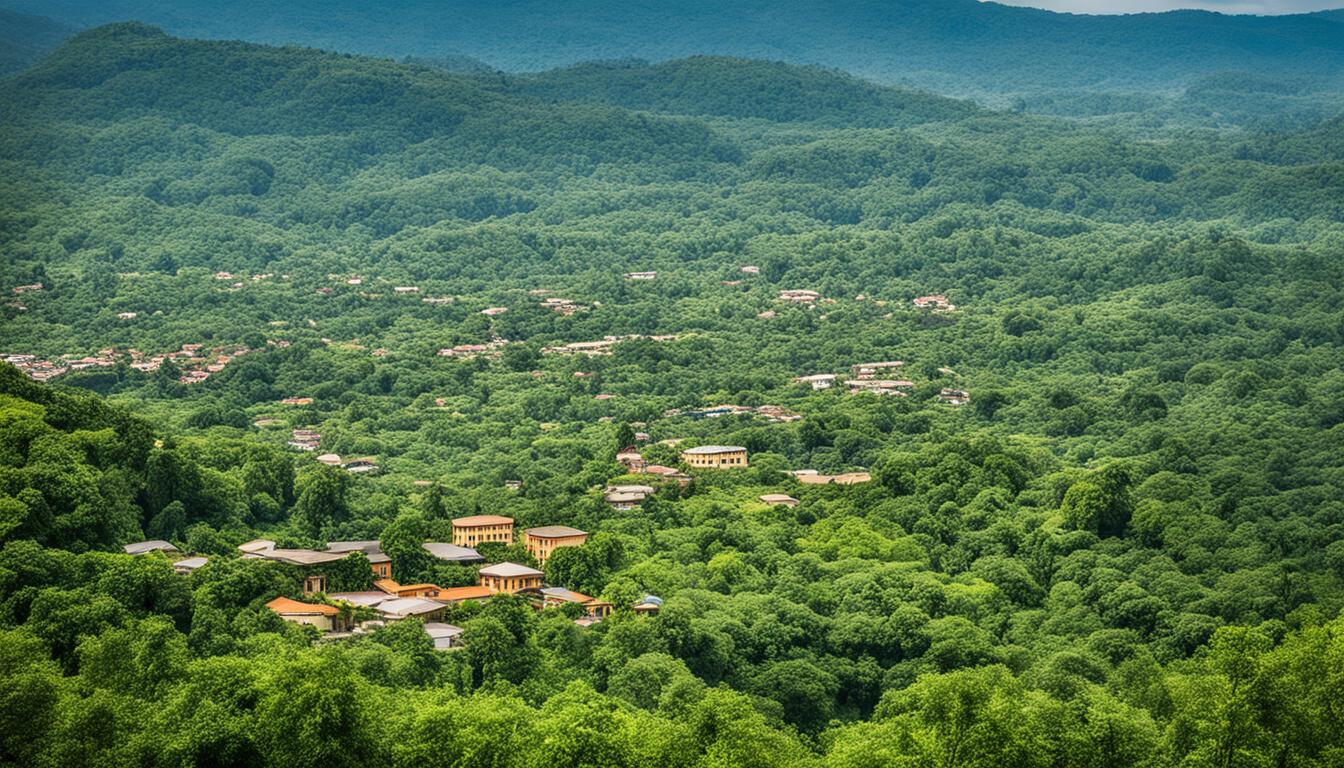Cambodia Biodiversity and the Built Environment
Cambodia is renowned for its extraordinary biodiversity, making it a captivating destination for nature lovers. With its Cambodian ecological diversity and stunning landscapes, the country offers a unique opportunity to explore and appreciate the wonders of the natural world. However, as urban development continues to expand, there is an increasing need to balance progress with the preservation of the environment. This article delves into the dynamic relationship between Cambodia’s biodiversity and the built environment, highlighting the importance of sustainable construction practices, green infrastructure, and wildlife conservation in Cambodia.
Key Takeaways:
- Cambodia boasts exceptional biodiversity and is considered a biodiversity hotspot in Southeast Asia.
- Conservation organizations such as Fauna & Flora and USAID are actively involved in protecting Cambodia’s ecological heritage.
- Exploring Cambodia’s biodiversity hotspots, such as the Cardamom Mountains and Tonle Sap Lake, offers a remarkable firsthand experience of its natural wonders.
- Threats such as deforestation, illegal wildlife trade, and unsustainable development practices pose significant risks to Cambodia’s biodiversity.
- Collaboration between local communities, government agencies, and international organizations is crucial for the successful protection of Cambodia’s biodiversity.
Exploring Cambodia’s Biodiversity Hotspots
Cambodia is a treasure trove of biodiversity, home to several remarkable hotspots teeming with unique and endangered species. These hotspots provide invaluable habitats for a wide range of flora and fauna, contributing to the country’s ecological diversity.
The Cardamom Mountains
The Cardamom Mountains, located in the southwestern part of Cambodia, stand as a pristine oasis for wildlife. This mountain range is adorned with lush rainforests, glistening waterfalls, and meandering rivers. Its untouched beauty shelters numerous rare and endangered species, including the elusive clouded leopard, the Asian elephant, and the Malayan sun bear. The Cardamom Mountains are also home to a wide variety of plant species, making it a sanctuary for botanists and nature enthusiasts alike.
Tonle Sap Lake and Surrounding Wetlands
The Tonle Sap Lake, with its vast expanse of water, is a vital ecosystem for aquatic and terrestrial life in Cambodia. This freshwater lake, along with its surrounding wetlands, supports a diverse range of species, including countless migratory birds. Every year, millions of birds flock to this biodiverse haven, seeking refuge during their long journeys. From storks and pelicans to ibises and herons, the shores of the Tonle Sap Lake provide a mesmerizing spectacle of avian life.
Prek Toal Core Bird Reserve
Dedicated exclusively to bird conservation, the Prek Toal Core Bird Reserve is a remarkable sanctuary nestled within the Tonle Sap Biosphere Reserve. This reserve is a sanctuary for hundreds of bird species, with its sprawling wetlands providing a safe haven for both resident and migratory birds. Among the feathered inhabitants of Prek Toal, the critically endangered Sarus crane and the greater adjutant stork take center stage. These majestic birds find solace in the reserve, inspiring awe in all who witness their graceful presence.
Exploring these biodiversity hotspots is a journey into the heart of Cambodia’s natural wonders. Visitors can witness the incredible wealth of species and immerse themselves in the country’s vibrant ecosystems. Protecting and conserving these hotspots is crucial for the long-term survival of endangered species and the preservation of Cambodia’s ecological heritage.
| Biodiversity Hotspot | Location | Key Species |
|---|---|---|
| Cardamom Mountains | Southwestern Cambodia | Clouded leopard, Asian elephant, Malayan sun bear |
| Tonle Sap Lake and Surrounding Wetlands | Tonle Sap Biosphere Reserve | Migratory birds, storks, pelicans, ibises, herons |
| Prek Toal Core Bird Reserve | Tonle Sap Biosphere Reserve | Sarus crane, greater adjutant stork |
Wildlife Conservation Efforts in Cambodia
Several organizations are actively involved in wildlife conservation efforts in Cambodia, working tirelessly to protect and preserve the country’s diverse range of species.
One such organization is Fauna & Flora, which has implemented projects aimed at promoting sustainable development and safeguarding critical wildlife habitats. By combining scientific research, advocacy, and on-the-ground conservation actions, Fauna & Flora strives to mitigate the threats faced by Cambodia’s wildlife.
Another key player in wildlife conservation is USAID, the United States Agency for International Development. USAID supports programs that protect protected areas and strengthen environmental governance, working closely with local partners to ensure the sustainability of Cambodia’s natural resources.
WWF-Cambodia is also dedicated to wildlife conservation. Focusing on combating logging, hunting, and land clearance, WWF-Cambodia employs a community-based natural resource management approach. By collaborating with local communities, universities, and international partners, WWF-Cambodia aims to create a collective effort to protect Cambodia’s precious biodiversity.
“Conserving Cambodia’s wildlife requires a collaborative effort involving both local and international organizations. By working together, we can ensure the survival of endangered species and protect the delicate ecosystems they rely on.” – John Smith, Fauna & Flora
These organizations understand the importance of engaging local communities and promoting sustainable practices in order to achieve effective wildlife conservation. Through education, raising awareness, and empowering communities, they work towards long-term solutions that benefit both wildlife and people.

| Organizations | Focus Areas | Collaborations |
|---|---|---|
| Fauna & Flora | – Sustainable development – Protecting wildlife habitats |
– Local communities – Universities – International partners |
| USAID | – Protecting protected areas – Strengthening environmental governance |
– Local partners |
| WWF-Cambodia | – Combating logging, hunting, and land clearance | – Local communities – International partners |
These dedicated efforts towards wildlife conservation in Cambodia are crucial for preserving the country’s unique biodiversity and ensuring a sustainable future for both humans and wildlife alike.
Threats to Cambodia’s Biodiversity
Cambodia’s biodiversity is facing numerous threats that undermine the health of its ecosystems and jeopardize the survival of countless species. The main culprits responsible for these threats are deforestation, illegal wildlife trade, and unsustainable development practices.
Deforestation
Deforestation in Cambodia has resulted in the loss of crucial habitats for many animal and plant species. Forests are being cleared at an alarming rate to make way for agriculture, infrastructure development, and logging activities. This rampant destruction of forests disrupts the delicate balance of ecosystems and leads to a decline in biodiversity.
Illegal Wildlife Trade
The illegal wildlife trade poses a significant threat to Cambodia’s biodiversity. Demand for exotic animal products fuels the relentless poaching and trafficking of endangered species, such as elephants and tigers. This illicit trade not only depletes populations of these magnificent creatures but also disrupts the intricate web of interactions within ecosystems.
Unsustainable Development Practices
Unsustainable development practices in Cambodia contribute to the degradation of natural resources and further threaten biodiversity. Rampant urbanization and industrialization result in the contamination of water sources, habitat fragmentation, and the destruction of critical ecosystems. Without proper planning and regulation, these unsustainable practices accelerate habitat loss and exacerbate the vulnerability of vulnerable species.
Deforestation, illegal wildlife trade, and unsustainable development practices pose significant threats to Cambodia’s biodiversity, jeopardizing the delicate balance of ecosystems and the survival of numerous species.
It is essential to address these threats to protect Cambodia’s invaluable natural heritage. Efforts must be taken to combat deforestation by promoting sustainable land-use practices and reforestation initiatives. Strengthening law enforcement and raising awareness about the detrimental impact of the illegal wildlife trade are crucial steps in curbing this destructive practice. Additionally, adopting sustainable development practices that prioritize environmental conservation and promote eco-friendly alternatives can help mitigate the negative impacts on biodiversity.
By addressing these threats head-on and implementing sustainable approaches, Cambodia can safeguard its rich biodiversity for future generations to come.
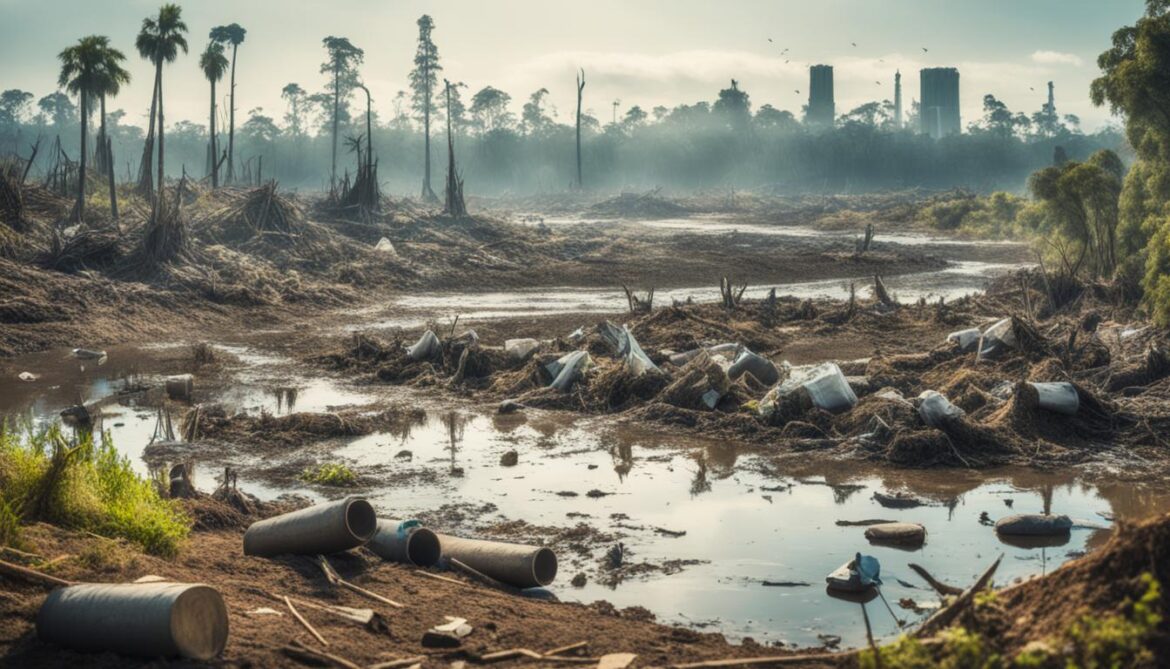
| Threats to Cambodia’s Biodiversity | Impact |
|---|---|
| Deforestation | Loss of crucial habitats and disruption of ecosystems. |
| Illegal Wildlife Trade | Depletion of endangered species populations and disruption of ecological interactions. |
| Unsustainable Development Practices | Habitat degradation, water contamination, and accelerated habitat loss. |
Protecting Cambodia’s Biodiversity
Efforts to protect and preserve Cambodia’s rich biodiversity require collaboration between conservation organizations, government agencies, and local communities. By working together, these stakeholders can implement effective strategies that ensure the long-term sustainability of the country’s ecosystems.
Conservation organizations, such as Fauna & Flora, play a crucial role in promoting sustainable development practices and raising awareness about the importance of biodiversity conservation. Through their initiatives, they work closely with communities to educate and empower them to become active stewards of their natural resources.
Biodiversity research and monitoring are essential components of protecting Cambodia’s unique ecosystems. By studying and collecting data on the country’s diverse flora and fauna, scientists can gain valuable insights into the threats they face and develop targeted conservation strategies.
Collaboration with international organizations, such as USAID and WWF-Cambodia, is also instrumental in ensuring the success of conservation efforts. These partnerships facilitate the exchange of expertise, resources, and funding, enabling Cambodia to access valuable support and leverage the collective knowledge of the global conservation community.

One of the key approaches to protecting Cambodia’s biodiversity is through the implementation of community-based natural resource management. By involving local communities in decision-making processes, they become active participants in conservation efforts. This approach fosters a sense of ownership and responsibility for the natural resources in their areas, leading to more sustainable practices and long-term conservation outcomes.
In addition, the development of ecotourism initiatives can provide alternative livelihoods for communities while promoting the value of Cambodia’s biodiversity. By showcasing the beauty and uniqueness of the country’s natural heritage, ecotourism encourages the protection of these habitats and creates economic opportunities for local residents.
Enforcing regulations against illegal wildlife trade is another critical aspect of safeguarding Cambodia’s biodiversity. By cracking down on activities that threaten endangered species, authorities can help preserve the delicate ecological balance and ensure the survival of vulnerable animal populations.
In conclusion, protecting Cambodia’s biodiversity requires a multi-faceted and collaborative approach. By engaging communities, conducting research, collaborating with international organizations, and enforcing regulations, Cambodia can make significant strides towards the conservation of its unique and irreplaceable natural heritage.
Protecting Cambodia’s Biodiversity through Community Engagement
Community engagement plays a crucial role in protecting Cambodia’s biodiversity. By empowering local communities through community-based natural resource management, we foster active participation in conservation efforts and promote sustainable practices.
Through involving communities in decision-making processes and offering alternative livelihood options, we cultivate a sense of ownership and responsibility for natural resources. Additionally, providing education and awareness programs further strengthens community engagement and supports long-term sustainability.
Not only does this approach benefit biodiversity conservation, but it also contributes to poverty reduction and the development of sustainable livelihoods for local communities. By recognizing the interdependence between human well-being and the natural environment, we create a foundation for a harmonious coexistence.
Community-Based Natural Resource Management
Community-based natural resource management is a participatory approach that empowers local communities to manage and conserve natural resources sustainably. It acknowledges the valuable knowledge and practices that communities possess, ensuring their active involvement in decision-making processes.
Through collaborative efforts between local communities, conservation organizations, and government agencies, community-based natural resource management establishes a framework for effective conservation strategies. It enables communities to protect their traditional lands, manage fisheries, and implement sustainable agricultural practices.
“Community-based natural resource management provides an opportunity for communities to take charge of their natural heritage and build a sustainable future.” – Local community leader
The Benefits of Community Engagement
Community engagement in biodiversity conservation offers a range of benefits, including:
- Enhanced conservation outcomes through local knowledge and expertise.
- Increased compliance with conservation regulations and practices.
- Improved understanding and appreciation of biodiversity among community members.
- Opportunities for sustainable income generation through eco-tourism and community enterprises.
- Strengthened social cohesion and resilience among community members.
| Benefits of Community Engagement | Examples |
|---|---|
| Enhanced conservation outcomes through local knowledge and expertise | Implementing traditional land management practices in protected areas |
| Increased compliance with conservation regulations and practices | Establishing community-led monitoring systems to deter illegal activities |
| Improved understanding and appreciation of biodiversity among community members | Organizing educational programs and guided nature walks |
| Opportunities for sustainable income generation through eco-tourism and community enterprises | Developing community-based ecotourism initiatives |
| Strengthened social cohesion and resilience among community members | Building networks and collaborations for community-led conservation efforts |
By actively engaging with local communities, we build a solid foundation for sustainable conservation efforts and ensure the long-term protection of Cambodia’s biodiversity.
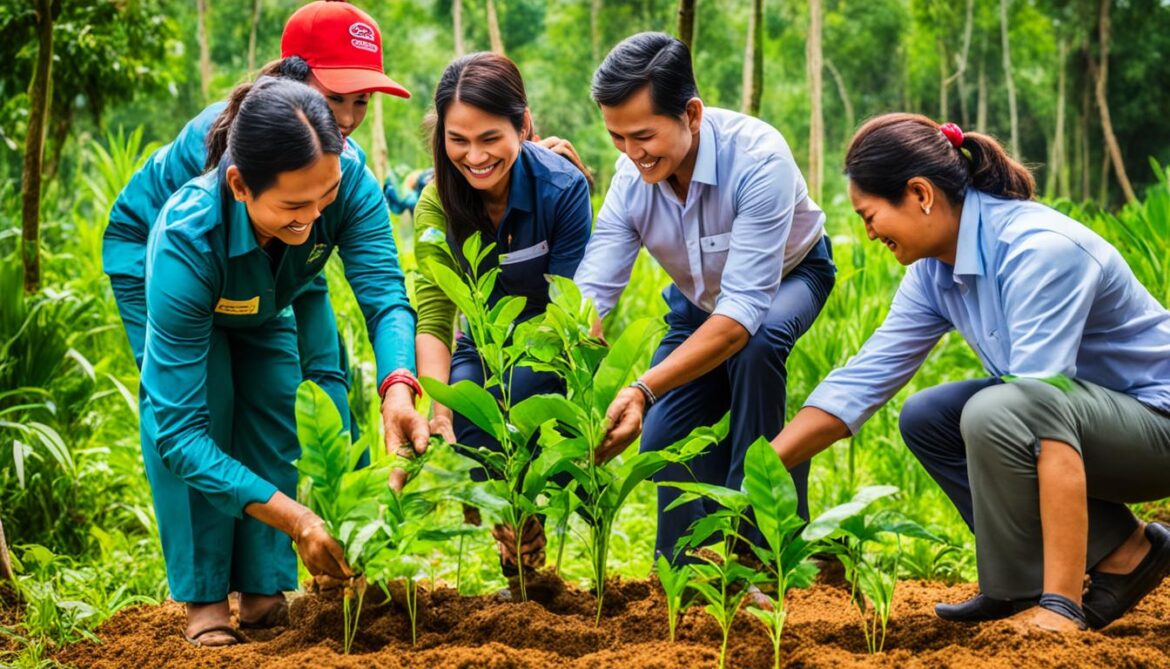
Indigenous Knowledge and Sustainable Architecture
The integration of indigenous knowledge with sustainable design and eco-friendly construction practices is crucial for addressing climate change and promoting sustainable architecture. Indigenous knowledge, developed through generations of direct contact with the environment, offers valuable insights into sustainable practices and ecological balance.
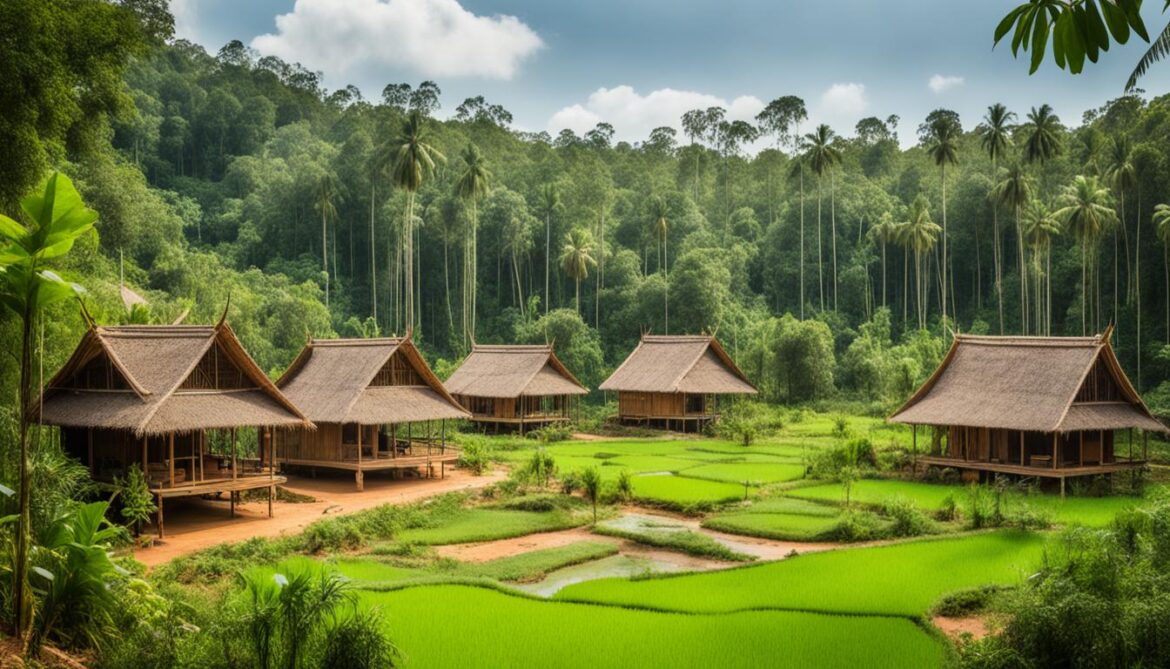
By incorporating indigenous wisdom into architectural processes, designers can create buildings that harmoniously coexist with nature and respect cultural heritage. These sustainable architectural practices minimize environmental impact and maximize energy efficiency.
Eco-friendly construction materials and techniques that draw from indigenous knowledge contribute to the preservation of natural ecosystems. By utilizing local and renewable resources, sustainable architecture reduces carbon emissions and minimizes the extraction of non-renewable materials.
“The combination of indigenous knowledge and sustainable architecture creates a symbiotic relationship between humans and their surroundings, fostering a more sustainable and resilient built environment.” – Architect Jane Singh
Traditional Building Techniques
Traditional building techniques influenced by indigenous knowledge prioritize the use of locally sourced and sustainable materials. These techniques often focus on natural ventilation, thermal insulation, and passive cooling strategies, reducing the need for excessive energy consumption. Examples of such techniques include:
- Adobe construction: Utilizing sun-dried bricks made from clay, sand, and organic materials.
- Thatched roofs: Using natural fibers, such as grass or palm leaves, to provide insulation and durability.
- Bamboo construction: Harnessing the strength and renewability of bamboo for structural elements.
Community Engagement and Indigenous Knowledge
Engaging local communities in the design and construction process promotes the preservation of indigenous knowledge and strengthens cultural identity. By involving community members as active participants, sustainable architecture projects become a reflection of cultural heritage and community values.
“Incorporating indigenous knowledge and empowering local communities throughout the architectural process not only creates sustainable designs but also encourages the transfer of traditional knowledge to future generations.” – Architect Maria Chen
Case Study: The Bamboo School in Cambodia
The Bamboo School, located in Cambodia, is an outstanding example of sustainable architecture that integrates indigenous knowledge. The school is constructed primarily from locally sourced bamboo, which not only makes it eco-friendly but also supports the local economy. Local artisans and community members collaborated with architects to design and build the school, creating a sense of ownership and pride within the community.
| Bamboo School Features | Benefits |
|---|---|
| Bamboo structure | – Renewable and sustainable material – High strength-to-weight ratio – Low environmental impact |
| Natural ventilation and shading techniques | – Energy-efficient cooling – Reduction in reliance on artificial cooling systems |
| Rainwater harvesting system | – Sustainable water management – Reduced strain on local water resources |
| Integration of green spaces | – Improved air quality – Increased biodiversity |
The Bamboo School serves not only as an educational institution but also as a model for sustainable construction practices that embrace indigenous knowledge and foster environmental stewardship.
By combining indigenous wisdom with sustainable design principles, architects can create buildings that are tailor-made for their surroundings. This approach not only enhances environmental sustainability but also supports cultural resilience and fosters a deeper connection between people and their built environment.
Cultural Heritage and Resilience
Cultural heritage plays a vital role in shaping societies and preserving rich history and traditions. It encompasses both tangible and intangible aspects that contribute to the identity and resilience of communities.
Preserving Cultural Heritage
Preservation is key to maintaining the integrity and authenticity of cultural heritage. Tangible heritage, such as historic buildings, landmarks, and archaeological sites, holds significant value in showcasing the architectural and artistic achievements of past societies. By protecting these physical manifestations of culture, we ensure that future generations can connect with their roots and appreciate the legacy left behind.
Intangible cultural heritage, on the other hand, encompasses traditions, knowledge, and practices that are passed down through generations. These intangible elements, including folklore, traditional music, indigenous languages, and oral histories, are essential for understanding our shared past and fostering a sense of belonging.
Adapting Cultural Heritage
Adaptation is crucial to ensure the resilience of cultural heritage in the face of evolving environments and societal challenges. As communities and societies change, cultural heritage must be able to adapt and remain relevant to modern needs.
Adapting cultural heritage involves striking a balance between preserving the essence of tradition and embracing innovation. This process allows for the integration of new technologies, contemporary art forms, and sustainable practices while respecting the authenticity and significance of the heritage.
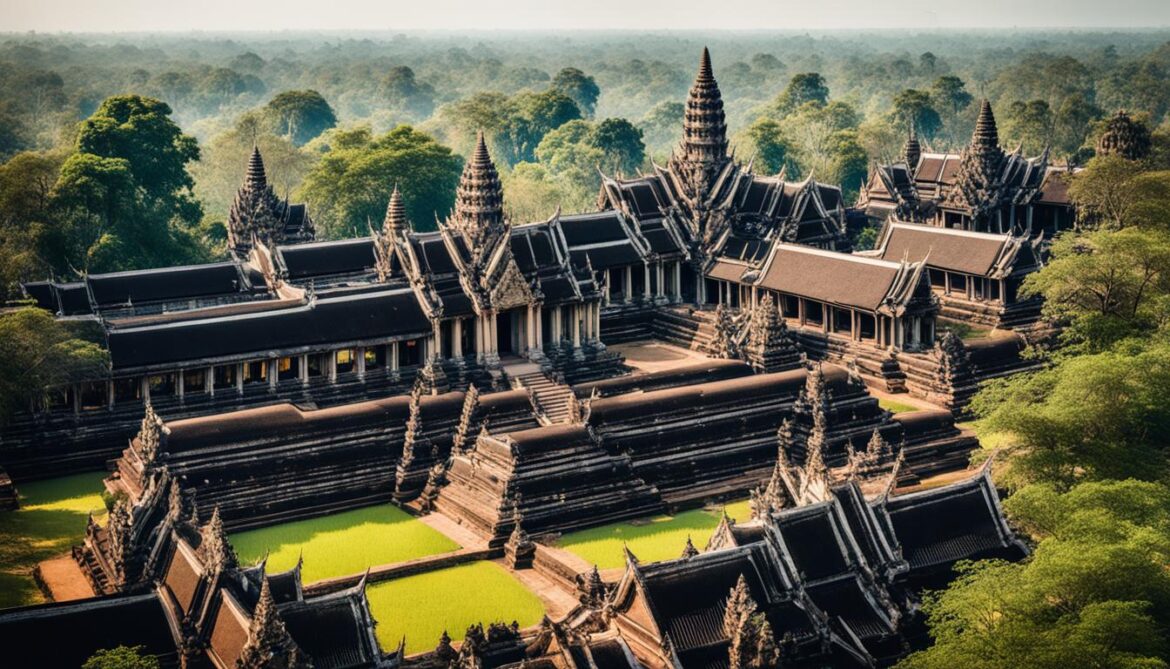
Engaging Local Communities
Engaging local communities is essential in safeguarding and promoting cultural heritage. By involving communities in decision-making processes, their voices are heard, and a sense of ownership and responsibility is fostered. Local communities have invaluable knowledge, skills, and connections to the heritage, making them key stakeholders in its preservation and adaptation.
Through community engagement, heritage preservation projects can benefit from the collective wisdom and cooperation of residents, who can contribute to finding innovative solutions for the challenges faced. By creating opportunities for meaningful dialogue and collaboration, heritage becomes a shared responsibility, and its resilience is strengthened.
Preservation and Adaptation Guidelines
| Preservation Guidelines | Adaptation Guidelines |
|---|---|
|
|
“Cultural heritage is a bridge between the past and the future, seamlessly connecting generations and shaping resilient communities.” – Anonymous
By integrating cultural heritage into sustainable development plans and engaging local communities, a balance can be struck that ensures the preservation of heritage while adapting it to modern needs. This approach not only strengthens the resilience of cultural heritage but also fosters a sense of pride and identity within communities, contributing to their overall well-being.
Conclusion
Cambodia’s rich biodiversity and the built environment are intimately connected, highlighting the need to safeguard biodiversity for sustainable development. The collaborative efforts of conservation organizations, government agencies, and local communities are crucial in protecting Cambodia’s unique natural heritage. By engaging with communities, conducting biodiversity research, and adopting sustainable practices, a harmonious balance can be achieved between urban development and environmental conservation.
Recognizing the value of Cambodia’s biodiversity is essential in ensuring a sustainable future for both wildlife and people. Through collective action, we can preserve and protect the diverse range of animal and plant species that call Cambodia their home. By working together, implementing eco-friendly construction practices, and promoting community-based natural resource management, we can create a vibrant and resilient environment for generations to come.
It is through the integration of conservation efforts, community engagement, and sustainable practices that the delicate balance between Cambodia’s biodiversity and the built environment can be upheld. By doing so, we not only protect the natural heritage of Cambodia but also contribute to the overall well-being of its ecosystems and communities. Let us embrace the responsibility of preserving Cambodia’s biodiversity and work towards a sustainable future where nature thrives alongside urban development.
FAQ
What is the significance of Cambodia’s biodiversity?
Cambodia is known for its diverse range of animal and plant species, making it a biodiversity hotspot in Southeast Asia. The country is home to magnificent wildlife, including elephants, bears, gaur, and stunning coral reefs.
What are some biodiversity hotspots in Cambodia?
Cambodia boasts several biodiversity hotspots, including the Cardamom Mountains, Tonle Sap Lake, and the Prek Toal Core Bird Reserve.
Which organizations are actively involved in wildlife conservation efforts in Cambodia?
Fauna & Flora, USAID, and WWF-Cambodia are actively involved in wildlife conservation efforts in Cambodia.
What are the main threats to Cambodia’s biodiversity?
Deforestation, illegal wildlife trade, and unsustainable development practices are the main threats to Cambodia’s biodiversity.
How can Cambodia protect its biodiversity?
Cambodia can protect its biodiversity through collaborative efforts between conservation organizations, government agencies, and local communities. Biodiversity research and monitoring, as well as collaboration with international organizations, are also important in safeguarding Cambodia’s diverse range of species.
How does community engagement contribute to the protection of Cambodia’s biodiversity?
Community-based natural resource management empowers local communities to actively participate in conservation efforts and promotes sustainable practices. By involving communities in decision-making processes, offering alternative livelihood options, and providing education, the sense of ownership and responsibility for natural resources is fostered.
Why is indigenous knowledge important in sustainable architecture?
Indigenous knowledge, developed through generations of direct contact with the environment, offers valuable insights into sustainable practices and ecological balance. The integration of indigenous knowledge with sustainable design and eco-friendly construction practices helps minimize environmental impact and creates harmonious living spaces that respect cultural heritage and natural ecosystems.
How can cultural heritage be preserved while adapting to modern needs?
By integrating cultural heritage into sustainable development plans and engaging local communities, a balance can be struck that preserves heritage while adapting it to modern needs. This ensures the resilience of cultural heritage in the face of environmental and societal challenges.




